Foresight as a Tool for the Planning and Implementation of Visions for Smart City Development
Abstract
1. Introduction
- Sustainable development—through the achievement of social and economic stability, effective, multifaceted management of the urban environment;
- Orientation towards citizens—planning should be focused on the needs of citizens, including elements such as life satisfaction, physical and mental health, level of independence, education, social relations, and cultural diversity;
- Effectiveness, attractiveness, and dynamics—these are necessary to attract investment and stimulate entrepreneurship;
- Accessibility—to enable local communities to participate in all aspects of city life;
- Resilience to crises and shocks, flexibility and competitiveness—the city should have the potential to adapt to changing social, economic and cultural conditions;
- Good governance—the city should make optimal use of its resources in order to effectively implement short and long-term development programmes;
- Responsiveness—it should have a rationally developed digital infrastructure to respond to emerging problems and make appropriate decisions in real time;
- Future-oriented—through appropriate city resource planning and management.
- It allows us to build a long-term development perspective for the smart city;
- It enables the detection of problems related to contemporary challenges of the smart city before they appear, and enables us to take preventive measures;
- It allows for an assessment of the consequences of current actions and decisions taken in the smart city;
- It enables a broadly understood creation of a smart city, anticipating the future and making the most effective solutions;
- It involves a large number of stakeholders in the development of the smart city, by means of which it will support the development of a vision of the future and development priorities that can be implemented;
- It creates an open ground for discussing the future of smart city development and allows a consensus to be reached in cases of divergent opinions and expectations among stakeholders;
- Due to the application of various research methods, it enables the confrontation of views of many stakeholders of smart city development;
- It strives to establish cooperation between stakeholders and arouses their sense of responsibility for the implementation of the results achieved.
2. Materials
2.1. Fundamentals of Foresight
- Communication—a platform enabling communication between partners involved in the process as well as the flow of information between organisers and the public concerned by the results of the undertaken initiative;
- Focus on the long-term perspective—focusing on the development of the future and thinking systematically about long-term processes;
- Coordination—partnership-based management of the knowledge generated by the project, as well as at the organisational level, managing activities within the implemented process;
- Consensus—reaching an agreement in cases of diverging opinions and expectations among the participants of the process which may result from a loss of compatibility of objectives or visions for the development of the research area, as well as in the context of the obtained results requiring implementation after completion;
- Consistency—systematic involvement of stakeholders in the long-term process in order to generate expertise necessary for executing different stages of the process, while eliminating problems associated with obstacles to participation in the initiative related to the performance of professional duties.
2.2. Methods Used in Foresight Research
- Creativity—methods using a combination of original thinking with creative invention (e.g., Wild Cards, Scenarios, Brainstorming, strengths, weaknesses, opportunities, and threats (SWOT) analysis);
- Expert knowledge—methods using the skills and knowledge of experts in a given field (e.g., Expert Panel, Key Technologies, Multi-Criteria Analysis, Impact Analysis);
- Interaction—methods based on creating new knowledge and building a vision for development with the involvement of a wide range of stakeholders (e.g., Surveys, Conferences, Workshops, Citizen Panels, Stakeholder Analysis);
- Facts—methods supporting the understanding of the current state of the research area (e.g., Literature Reviews, Weak Signals, Scanning, Bibliometrics).
3. Methods
- Identifying factors influencing foresight research methodology;
- Selecting foresight research methods in line with the classification, research context and stages of the foresight process;
- Selecting methodological hybrids;
- Constructing a hybrid system.
- Sequential—output values from one method become input values in the next method. It is used when the results of a method from one stage of foresight constitute input to the next stage;
- Loosely related—information is exchanged between individual methods, even though each method works separately;
- Nested—a high degree of integration. There is a frequent interweaving and exchange of information between the applied methods (multiple feedbacks). This structure allows for major and auxiliary methods. Information flow takes place in both directions;
- Supporting—they are characterised by a clear division into basic and supporting methods. An auxiliary method (not always active) may use the same input as the basic method. However, the results of the auxiliary method must be processed by means of the main method [92].
4. Results
4.1. Methodology of Planning and Implementation of the Vision of Smart City Development
4.2. Operationalisation of the Methodology for Planning and Implementation of the Vision of Smart City Development
- Stage 1: initiation, megatrend analysis, STEEPVL, structural analysis;
- Stage 2: Delphi;
- Stage 3: scenarios—creative visioning;
- Stage 4: NCRR;
- Stage 5: evaluation and resumption.
- Where I live in 2050 is…
- What I wish was different is…
- In my free time, I…
- The main thing I worry about is…
- What I love about my city is…
5. Conclusions
Funding
Conflicts of Interest
References
- Faramehr, S.; Hemida, H.; Fujiyama, T. Evaluation of the impact of urban water systems on railways: The scenario of track flooding caused by a water main burst. Proc. Inst. Mech. Eng. Part F J. Rail Rapid Transit 2020, 234, 351–358. [Google Scholar] [CrossRef]
- Juwet, G.; Ryckewaert, M. Energy transition in the nebular city: Connecting transition thinking, metabolism studies, and urban design. Sustainability 2018, 10, 955. [Google Scholar] [CrossRef]
- Caparros–Midwood, D.; Dawson, R.; Barr, S. Low carbon, low risk, low density: Resolving choices about sustainable development in cities. Cities 2019, 89, 252–267. [Google Scholar] [CrossRef]
- Munoz–Pandiella, I.; Bosch, C.; Merillou, N.; Patow, G.; Merillou, S.; Pueyo, X. Urban weathering: Interactive rendering of polluted cities. IEEE Trans. Vis. Comput. Graph. 2018, 24, 3239–3252. [Google Scholar] [CrossRef] [PubMed]
- Amritha, P.K.; Kumar, P.P.A. Productive landscapes as a sustainable organic waste management option in urban area. Environ. Dev. Sustain. 2019, 21, 709–726. [Google Scholar] [CrossRef]
- Bugge, M.M.; Fevolden, A.M.; Klitkou, A. Governance for system optimization and system change: The case of urban waste. Res. Policy 2019, 48, 1076–1090. [Google Scholar] [CrossRef]
- Mahmud, J. City foresight and development planning case study: Implementation of scenario planning in formulation of the Bulungan development plan. Futures 2011, 43, 697–706. [Google Scholar] [CrossRef]
- Kovács, Z.; Farkas, Z.J.; Egedy, T.; Kondor, A.C.; Szabó, B.; Lennert, J.; Baka, D.; Kohán, B. Urban sprawl and land conversion in post–socialist cities: The case of metropolitan Budapest. Cities 2019, 92, 71–81. [Google Scholar] [CrossRef]
- Bjørgen, A.; Seter, H.; Kristensen, T.; Pitera, K. The potential for coordinated logistics planning at the local level: A Norwegian in–depth study of public and private stakeholders. J. Transp. Geogr. 2019, 76, 34–41. [Google Scholar] [CrossRef]
- Czerewacz-Filipowicz, K. The Eurasian economic union as an element of the belt and road initiative. Comp. Econ. Res. 2019, 22, 23–37. [Google Scholar] [CrossRef]
- Greenfield, E.A. Age–friendly initiatives, social inequalities, and spatial justice. Hastings Cent. Rep. 2018, 48, 41–45. [Google Scholar] [CrossRef]
- Jarocka, M.; Wang, H. Definition and classification criteria of logistics services for elderly. Eng. Manag. Prod. Ser. 2018, 10, 65–75. [Google Scholar] [CrossRef]
- Lanjouw, P.; Marra, M.R. Urban poverty across the spectrum of Vietnam’s towns and cities. World Dev. 2018, 110, 295–306. [Google Scholar] [CrossRef]
- Ma, B.; Li, H.; Wei, Y.D.; Xue, D.; Jiang, J. Spatial structure and mechanism of urban poverty in Xi’an city. Acta Geogr. Sin. 2018, 73, 1018–1032. [Google Scholar] [CrossRef]
- de CastroPena, J.C.; de Assis, J.C.; da Silva, R.A.; Honda, L.K.; Pagani, M.I.; Ribeiro, M.C. Beyond the mining pit: The academic role in social deliberation for participatory environmental planning. Perspect. Ecol. Conser. 2017, 15, 194–198. [Google Scholar] [CrossRef]
- van Holm, E.J. Unequal cities, unequal participation: The effect of income inequality on civic engagement. Am. Rev. Public Adm. 2019, 49, 135–144. [Google Scholar] [CrossRef]
- Fernandez-Guell, J.M.; Guzmán-Arana, S.; Collado-Lara, M.; Fernandez-Anez, V. How to incorporate urban complexity, diversity and intelligence into smart cities initiative. In Proceedings of the First International Conference, Smart–CT 2016, Málaga, Spain, 15–17 June 2016; pp. 85–94. [Google Scholar]
- Ravetz, J. From ‘Smart’ Cities to ‘Wise’: Synergistic Pathways for Collective Urban Intelligence. JPI Urban Europe—Urban Transitions Pathways Symposium 2017. Available online: https://jpi-urbaneurope.eu/app/uploads/2017/04/Ravetz_From-smart-to-wise.pdf (accessed on 15 November 2019).
- Naphade, M.; Banavar, G.; Harrison, C.; Paraszczak, J.; Morris, R. Smarter cities and their innovation challenge. Computer 2011, 44, 32–39. [Google Scholar] [CrossRef]
- Bashynska, I.; Dyskina, A. The overview–analytical document of the international experience of building smart city. J. Bus. Theory Prac. 2018, 19, 228–241. [Google Scholar] [CrossRef]
- Winkowska, J.; Szpilko, D.; Pejić, S. Smart city concept in the light of the literature review. Eng. Manag. Prod. Serv. 2019, 11, 70–86. [Google Scholar] [CrossRef]
- Lee, J.H.; Gong Hancock, M.; Hu, M.-C. Towards an effective framework for building smart cities: Lessons from Seoul and San Francisco. Technol. Forecast. Soc. Chang. 2014, 89, 80–99. [Google Scholar] [CrossRef]
- Caragliu, A.; Del Bo, C.; Nijkamp, P. Smart cities in Europe. J. Urban Technol. 2011, 18, 65–82. [Google Scholar] [CrossRef]
- Zanella, A.; Bui, N.; Castellani, A.; Vangelista, L.; Zorzi, M. Internet of things for smart cities. IEEE Internet Things J. 2014, 1, 22–32. [Google Scholar] [CrossRef]
- Peng, G.C.A.; Nunes, M.B.; Zheng, L. Impacts of low citizen awareness and usage in smart city services: The case of London’s smart parking system. ISeB 2017, 15, 845–876. [Google Scholar] [CrossRef]
- Guo, J.; Ma, J.; Li, X.; Zhang, J.; Zhang, T. An attribute–based trust negotiation protocol for D2D communication in smart city balancing trust and privacy. J. Inf. Sci. Eng. 2017, 33, 1007–1023. [Google Scholar] [CrossRef]
- Chong, M.; Habib, A.; Evangelopoulos, N.; Park, H.W. Dynamic capabilities of a smart city: An innovative approach to discovering urban problems and solutions. Gov. Inform. Q. 2018, 35, 682–692. [Google Scholar] [CrossRef]
- Zhuhadar, L.; Thrasher, E.; Marklin, S.; de Pablos, P.O. The next wave of innovation—Review of smart cities intelligent operation systems. Comput. Hum. Behav. 2017, 66, 273–281. [Google Scholar] [CrossRef]
- Tomaszewska, E.J.; Florea, A. Urban smart mobility in the scientific literature—Bibliometric analysis. Eng. Manag. Prod. Ser. 2018, 10, 41–56. [Google Scholar] [CrossRef]
- Díaz-Díaz, R.; Muñoz, L.; Pérez-González, D. The business model evaluation tool for smart cities: Application to smart Santander use cases. Energies 2017, 10, 262. [Google Scholar] [CrossRef]
- Sharifi, A. A critical review of selected smart city assessment tools and indicator sets. J. Clean. Prod. 2019, 233, 1269–1283. [Google Scholar] [CrossRef]
- Meijer, A.; Bolívar, M.P.R. Governing the smart city: A review of the literature on smart urban governance. Int. Rev. Adm. Sci. 2016, 82, 392–408. [Google Scholar] [CrossRef]
- Nam, T.; Pardo, T.A. The changing face of a city government: A case study of Philly311. Gov. Inform. Q. 2014, 31, S1–S9. [Google Scholar] [CrossRef]
- Grassl, G.C.; Groß, P. Smart city. In Sustainable Urban Planning. Vibrant Neighbourhoods Smart Cities Resilience; Bott, H., Grassl, G.C., Anders, S., Eds.; Edition Detail: Munich, Germany, 2019; pp. 25–27. Available online: https://www.academia.edu/41196971/Vibrant_Neighbourhoods_Smart_Cities_Resilience_Sus_tainable_Urban_Planning (accessed on 12 March 2020).
- Mizielińska–Chmielewska, M. Inteligentne Miasta Podążają Za Modelem Ekonomii Współdzielenia (Smart Cities Follow the Sharing Economy Model). Available online: http://www.inteligentnemiasto.com/smart-cities/inteligentne-miasta-podazaja-za-modelem-ekonomii-wspoldzielenia (accessed on 15 November 2019).
- Ortiz-Fournier, L.V.; Márquez, E.; Flores, F.R.; Rivera-Vázquez, J.C.; Colon, P.A. Integrating educational institutions to produce intellectual capital for sustainability in Caguas, Puerto Rico. KMRP 2010, 8, 203–215. [Google Scholar] [CrossRef]
- Woetzel, J.; Remes, J.; Boland, B.; Lv, K.; Sinha, S.; Strube, G.; Means, J.; Law, J.; Cadena, A.; von der Tann, V. Smart Cities: Digital Solutions for Amore Livable Future; McKinsey Global Institute: New York, NY, USA, 2018; pp. 1–152. [Google Scholar]
- Giourka, P.; Sanders, M.W.J.L.; Angelakoglou, K.; Pramangioulis, D.; Nikolopoulos, N.; Rakopoulos, D.; Tryferidis, A.; Tzovaras, D. The smart city business model canvas—A smart city business modeling framework and practical tool. Energies 2019, 12, 4798. [Google Scholar] [CrossRef]
- Trencher, G. Towards the smart city 2.0: Empirical evidence of using smartness as a tool for tackling social challenges. Technol. Forecast. Soc. Chang. 2019, 142, 117–128. [Google Scholar] [CrossRef]
- Huang, K.; Zhang, X.S.; Wang, X.F. Block–level message–locked encryption with polynomial commitment for IoT data. J. Inf. Sci. Eng. 2017, 33, 891–905. [Google Scholar] [CrossRef]
- Bonenberg, W.W. Miasto Przyszłości (City of Tommorow). Available online: http://buildercorp.pl/2018/02/27/miasto-przyszlosci/ (accessed on 23 September 2019).
- Parnell, S. Cities, concepts, ideals. In Urban Studies—Society. Key Issues in the 21st Century; Parnell, S., Ed.; Sage: London, UK, 2012. [Google Scholar]
- Miodownik, M. Materials for the 21st century, what will we dream up next? MRS Bull. 2015, 40, 1188–1197. [Google Scholar] [CrossRef]
- Cities of Tomorrow. Challenges, Visions, Ways Forward; European Commission, Directorate General for Regional Policy: Brussel, Belgium, 2011. [Google Scholar]
- Paskaleva, K.; Cooper, I.; Linde, P.; Peterson, B.; Götz, C. Stakeholder engagement in the smart city: Making living labs work. In Transforming City Governments for Successful smart Cities; Public Administration and Information Technology; Rodríguez-Bolívar, M., Ed.; Springer: Cham, Switzerland, 2015. [Google Scholar] [CrossRef]
- Pereira, G.V.; Cunha, M.A.; Lampoltshammer, T.J.; Parycek, P.; Testa, M.G. Increasing collaboration and participation in smart city governance: A cross–case analysis of smart city initiative. Inf. Technol. Dev. 2017, 23, 526–553. [Google Scholar] [CrossRef]
- UNIDO Technology Foresight Manual. Organization and Method Volume 1; United Nations Industrial Development Organization: Vienna, Austria, 2005. [Google Scholar]
- Martin, B.R. Foresight in science and technology. Technol. Anal. Strat. Manag. 1995, 7, 139–168. [Google Scholar] [CrossRef]
- Georghiou, L. The UK technology foresight programme. Futures 1996, 28, 359–377. [Google Scholar] [CrossRef]
- Jakuszewicz, I.; Kononiuk, A.; Magruk, A.; Nazarko, J. Inicjatywy foresight w Polsce i na świecie (Foresight initiatives in Poland and in the world). In Multimedia W Organizacjach Gospodarczych I Edukacji (Multimedia in Business and Education Organizations); Kiełtyka, L., Ed.; Difin: Warszawa, Poland, 2006; pp. 138–144. [Google Scholar]
- Popper, R.; Keenan, M.; Miles, I.; Butter, M.; Sainz, G. Global Foresight Outlook 2007; The European Foresight Monitoring Network 2007. Available online: http://projects.mcrit.com/foresightlibrary/attachments/article/1066/efmn.global.foresight.outlook_Popper.et.al.2007.pdf (accessed on 15 October 2019).
- Kuwahara, T.; Cuhls, K.; Georghiou, L. Foresight in Japan. In The Handbook of Technology Foresight: Concepts and Practice; Prime Series on Research and Innovation Policy; Georghiou, L., Cassingena Harper, J., Keenan, M., Miles, I., Popper, R., Eds.; Edward Elgar: Cheltenham, Northampton, UK, 2008; pp. 170–184. [Google Scholar]
- LaColla, A. Atlanta VISION 2020: The Process and Citizen Participation a Case Study; URP 5122: Atlanta, GA, USA, 1999. [Google Scholar]
- Future of Cities: Foresight for Citie. A Resource for Policy-Makers; Government Office for Science: London, UK, 2016. Available online: https://assets.publishing.service.gov.uk/government/uploads/system/uploads/attachment_data/file/516443/gs-16-5-future-cities-foresight-for-cities.pdf (accessed on 23 September 2019).
- Guell, J.M.F.; Redondo, L. Linking territorial foresight and urban planning. Foresight 2012, 14, 316–335. [Google Scholar] [CrossRef]
- Czajor, M.; Koszewska, M.; Król, J.; Kuźmińska, A.; Słupiński, M. Jaka Przyszłość Czeka Konin? Konin 2050 (What Future for Konin? Konin 2050); Pracownia Miejska (Urban Workshop): Konin, Poland, 2015. [Google Scholar]
- Coates, J.F. Foresight in federal government policy making. FRQ 1985, 1, 29–53. [Google Scholar]
- Miles, I. Appraisal of Alternative Methods and Procedures for Producing Regional Foresight. Contribution to: Mobilising the Regional Foresight Potential; University of Manchester: Manchester, UK, 2002; Available online: http://pl.scribd.com/doc/36405036/Appraisal-of-Alternative-Methods-for-Foresight#scribd (accessed on 15 October 2019).
- Loveridge, D.; Saritas, O. Reducing the democratic deficit in institutional foresight programmes: A case for critical systems thinking in nanotechnology. Technol. Forecast. Soc. Chang. 2009, 76, 1208–1221. [Google Scholar] [CrossRef]
- Keenan, M.; Miles, I. A Practical Guide to Regional Foresight; Institute for Prospective Technological Studies; FOREN Network: Seville, Spain, 2001. [Google Scholar]
- Gavigan, J.P.; Scapolo, F.; Keenan, M.; Miles, I.; Farhi, F.; Lecoq, D.; Capriati, M.; Di Bartolomeo, T. A Practical Guide to Regional Foresight, Report EUR 20128 EN; Foresight for Regional Development Network (FOREN), European Communities: Brussels, Belgium, 2001. [Google Scholar]
- Anderson, J. Technology foresight for competitive advantage. Long Range Plann. 1997, 30, 665–677. [Google Scholar] [CrossRef]
- Kuciński, J. Organizacja I Prowadzenie Projektów Foresight W Świetle Doświadczeń Międzynarodowych (Organization and Carrying out of Foresight Projects in the Light of International Experience); Instytut Podstawowych Problemów Techniki PAN: Warszawa, Poland, 2006. [Google Scholar]
- Loveridge, D.; Street, P. Inclusive foresight. Foresight 2005, 7, 31–47. [Google Scholar] [CrossRef]
- Miles, I.; Cassingena Harper, J.; Georghiou, L.; Keenan, M.; Popper, R. The many faces of foresight. In The Handbook of Technology Foresight: Concepts and Practice; Prime Series on Research and Innovation, Policy; Georghiou, L., Cassingena Harper, J., Keenan, M., Miles, I., Popper, R., Eds.; Edward Elgar: Cheltenham, Northampton, UK, 2008; pp. 3–23. [Google Scholar]
- Webster, A. Foresight as a tool for the management of knowledge flows. In Proceedings of the strata Consolidating Workshop, Session 5, Brussels, Belgium, 22–23 April 2002. [Google Scholar]
- Barker, D.; Smith, D.J.H. Technology foresight using roadmaps. Long Range Plann. 1995, 28, 21–28. [Google Scholar] [CrossRef]
- Salmenkaita, J.P.; Salo, A. Emergent foresight processes: Industrial activities in wireless communications. Technol. Forecast. Soc. Chang. 2004, 71, 897–912. [Google Scholar] [CrossRef]
- Martin, B.R. Research Foresight and the Exploitation of the Science Base; Office of Science and Technology; HMSO: London, UK, 1993. [Google Scholar]
- Ravetz, J. Synergistics: An Overview. Available online: https://urban3dotnet.files.wordpress.com/2018/11/synergistics-overview-2-june-2018.pdf (accessed on 30 October 2019).
- Ravetz, J.; Miles, I.D. Foresight in cities: On the possibility of a strategic urban intelligence. Foresight 2016, 18, 469–490. [Google Scholar] [CrossRef]
- Dixon, T.; Montgomery, J.; Horton-Baker, N.; Farrelly, L.; Using, L. Urban foresight techniques in city visioning: Lessons from the Reading 2050 vision. Local Econ. 2018, 33, 777–799. [Google Scholar] [CrossRef]
- Foresight as a Strategic Long-Term Planning Tool for Developing Countries; UNDP: Singapore, 2014.
- Kamińska, K.; Pięta-Kanurska, M.; Snitsaruk, A. Wrocław. Rewers. Scenariusze Dla Miasta Przyszłości Foresight Społeczny Wrocław 2036/2056 (Wroclaw. Reverse. Scenarios for the City of the Future Social Foresight Wroclaw 2036/2056); Miasto Przyszłości: Laboratorium Wrocław (City of the Future: Laboratory Wroclaw): Wroclaw, Poland, 2016. [Google Scholar]
- Bendyk, E.; Król, J.; Kuźmińska, A. Foresight Lublin 2050; Urząd Miasta Lublin (Lublin City Hall): Lublin, Poland, 2018. [Google Scholar]
- Król, J. Rustavi 2050. Final Report; Pracownia Miejska (Urban Workshop): Rustavi, Georgia, 2018. [Google Scholar]
- Gould, S. Maroochy 2025 community visioning & action–a case study of anticipatory action learning practices in use within Maroochy Shire, Queensland, Australia. J. Futures Stud. 2005, 10, 125–131. [Google Scholar]
- Eames, M.A.; Marvin, B.; Hodson, M.B.; Dixon, T.; Guthrie, P.S.; Lannon, S. Briefing: Re–engineering the city 2020–2050—Urban foresight and transition management. Proc. Inst. Civil Eng. Urban Design Plann. 2014, 67, 1–4. [Google Scholar] [CrossRef]
- Dixon, T.; Lannon, S.; Eames, M. Reflections on disruptive energy innovation in urban retrofitting: Methodology, practice and policy. Energy Res. Soc. Sci. 2018, 37, 255–259. [Google Scholar] [CrossRef]
- Gudowsky, N.; Sotoudeha, M.; Caparia, L.; Wilfing, H. Transdisciplinary forward–looking agenda setting for age–friendly, human centered cities. Futures 2017, 90, 16–30. [Google Scholar] [CrossRef]
- Magruk, A.; Jańczuk, E. Typologia i klasyfikacja metod badawczych foresightu technologicznego (Typology and classification of research methods in technological foresight). In Koniunktura Gospodarcza a Reakcje Podmiotów Gospodarujących (Economic Situation and Reactions of Economic Entities); Czech–Rogosz, J., Ed.; Wydawnictwo Akademii Ekonomicznej: Katowice, Poland, 2009. [Google Scholar]
- Nazarko, J. Regionalny Foresight Gospodarczy. Metodologia I Instrumentarium Badawcze (Regional Economic Foresight. Methodology and Research Instruments); Związek Pracodawców Warszawy i Mazowsza: Warszawa, Poland, 2013. [Google Scholar]
- Futures Diamond. Available online: http://www.futuresdiamond.com/en/the-diamond (accessed on 30 October 2019).
- Szpilko, D. The methods used in the construction of a tourism development strategy in the regions. A case study of Poland. Procedia Soc. Behav. Sci. 2014, 156, 157–160. [Google Scholar] [CrossRef][Green Version]
- Magruk, A. Innovative classification of technology foresight methods. Tech. Econ. Dev. Economy 2011, 17, 700–716. [Google Scholar] [CrossRef]
- Alexandrova, M.; Marinova, D.; Tchonkova, D.; Keenan, M.; Popper, R.; Havas, A. Practical Guide for Integrating Foresight in Research Infrastructures Policy Formulation. ForeIntegra—RI. 2007. Available online: https://wbc-rti.info/object/document/7342/attach/ForeIntegra_PracticalGuide_printed.pdf (accessed on 15 October 2019).
- Popper, R. Foresight methodology. In The Handbook of Technology Foresight: Concepts and Practice; Prime Series on Research and Innovation, Policy; Georghiou, L., Cassingena Harper, J., Keenan, M., Miles, I., Popper, R., Eds.; Edward Elgar: Cheltenham, Northampton, UK, 2008; pp. 44–89. [Google Scholar]
- Popper, R. How are foresight methods selected? Foresight 2008, 10, 62–89. [Google Scholar] [CrossRef]
- Martin, B.R.; Irvine, J. Research Foresight: Priority–Setting in Science; Pinter Publishers: London, UK, 1989. [Google Scholar]
- Voros, J. A generic foresight process framework. Foresight 2003, 5, 10–21. [Google Scholar] [CrossRef]
- Bishop, P.; Hines, A.; Collins, T. The current state of scenario development: An overview of techniques. Foresight 2007, 9, 5–25. [Google Scholar] [CrossRef]
- Magruk, A. Referencyjna metodyka projektowania systemów hybrydowych w badaniach przyszłości (Reference methodology for designing hybrid systems in future research). Organ. I Zarządzanie 2014, 73, 385–397. [Google Scholar]
- Magruk, A. Kluczowe czynniki kształtujące metodykę badawczą projektów foresightowych (Key factors shaping the research methodology of foresight projects). Przegląd Organ. 2013, 9, 3–9. [Google Scholar] [CrossRef]
- Szpilko, D. NCRR—New foresight research method. In Proceedings of the 21th International Scientific Conference: Economics and Management, Proceeding of Selected Papers, Brno University of Technology, Brno, Czech Republic, 19–20 May 2016; pp. 612–620. [Google Scholar]
- Ringland, G. UNIDO Technology Foresight for Practitioner. In Proceedings of the A Specialised Course on Scenario Building, Prague, Czech Republic, 5–8 November 2007. [Google Scholar]
- Skea, J.; Wang, X.; Winksel, M. UK Energy in an era of globalization: Trends, technologies and environmental impact. In Energy 2050 Making the Transition to a Secure Low–Carbon Energy System; Skea, J., Ekins, P., Winskel, M., Eds.; Routledge: London, UK, 2011; pp. 11–40. [Google Scholar] [CrossRef]
- Ejdys, J.; Halicka, K.; Nazarko, Ł.; Kononiuk, A.; Olszewska, A.M.; Nazarko, J. Factor analysis as a tool supporting STEEPVL approach to the identification of driving forces of technological innovation. Procedia Eng. 2017, 182, 491–496. [Google Scholar] [CrossRef]
- Arcade, J.; Godet, M.; Meunier, F.; Roubelat, F. Structural Analysis with the MICMAC Method & Actors‘ Strategy with Mactor Method; AC/UNU Millennium Project Futures Research Methodology: Paris, France, 1994. [Google Scholar]
- Nazarko, J.; Ejdys, J.; Halicka, K.; Nazarko, Ł.; Kononiuk, A.; Olszewska, A.M. Structural analysis as an instrument for identification of critical drivers of technology development. Procedia Eng. 2017, 182, 474–481. [Google Scholar] [CrossRef]
- Ejdys, J.; Gudanowska, A.; Halicka, K.; Kononiuk, A.; Magruk, A.; Nazarko, J.; Nazarko, Ł.; Szpilko, D.; Widelska, U. Foresight in Higher Education Institutions: Evidence from Poland. Foresight STI Gov. 2019, 13, 77–89. [Google Scholar] [CrossRef]
- Loo, R. The Delphi method: A powerful tool for strategic management. Policing: Int. J. Police Strat. Manag. 2002, 25, 762–769. [Google Scholar] [CrossRef]
- Skulmoski, G.J.; Hartman, F.T.; Krahn, J. The Delphi method for graduate research. Int. J. Inf. Educ. Technol. 2007, 6, 1–21. [Google Scholar] [CrossRef]
- Steinert, M. A dissensus based online Delphi approach: An explorative research tool. Technol. Forecast. Soc. Chang. 2009, 76, 291–300. [Google Scholar] [CrossRef]
- Rowe, G.; Wright, G. The Delphi technique as a forecasting tool: Issues and analysis. Int. J. Forecast. 1999, 15, 353–375. [Google Scholar] [CrossRef]
- Szpilko, D. The use of Delphi method in the process of building a tourism development strategy in the region. Econ. Manag. 2014, 4, 329–346. [Google Scholar] [CrossRef]
- Mendonça, S.; e Cunha, M.P.; Ruff, F.; Kaivo-oja, J. Venturing into the wilderness: Preparing for wild cards in the civil aircraft and asset-management industries. Long Range Plann. 2009, 42, 23–41. [Google Scholar] [CrossRef]
- van’t Klooster, A.; van Asselt, M.B.A. Practising the scenario–axes technique. Futures 2006, 38, 15–30. [Google Scholar] [CrossRef]
- Kononiuk, A.; Nazarko, J. Scenariusze W Antycypowaniu I Kształtowaniu Przyszłości (Scenarios in Anticipation and Shaping the Future); Wolters Kluwer: Warszawa, Poland, 2014. [Google Scholar]
- Larsen, G. Why megatrends matter. Futureorientation 2006, 5, 8–14. [Google Scholar]
- Popper, R. Mapping Foresight: Revealing How Europe and Other World Regions Navigate into the Future; EFMN, Publications Office of the European Union: Brussels, Belgium, 2009. [Google Scholar]
- Slaughter, R.A. Futures for the Third Millennium: Enabling the Forward View; Prospect Media: Sydney, Australia, 1999. [Google Scholar]
- Major, E.; Asch, D.; Cordey–Haye, M. Foresight as a core competence. Futures 2001, 33, 91–107. [Google Scholar] [CrossRef]
- Ekman, U. Smart city planning: Complexity. Int. J. E Plan. Res. 2018, 7, 1–21. [Google Scholar] [CrossRef]
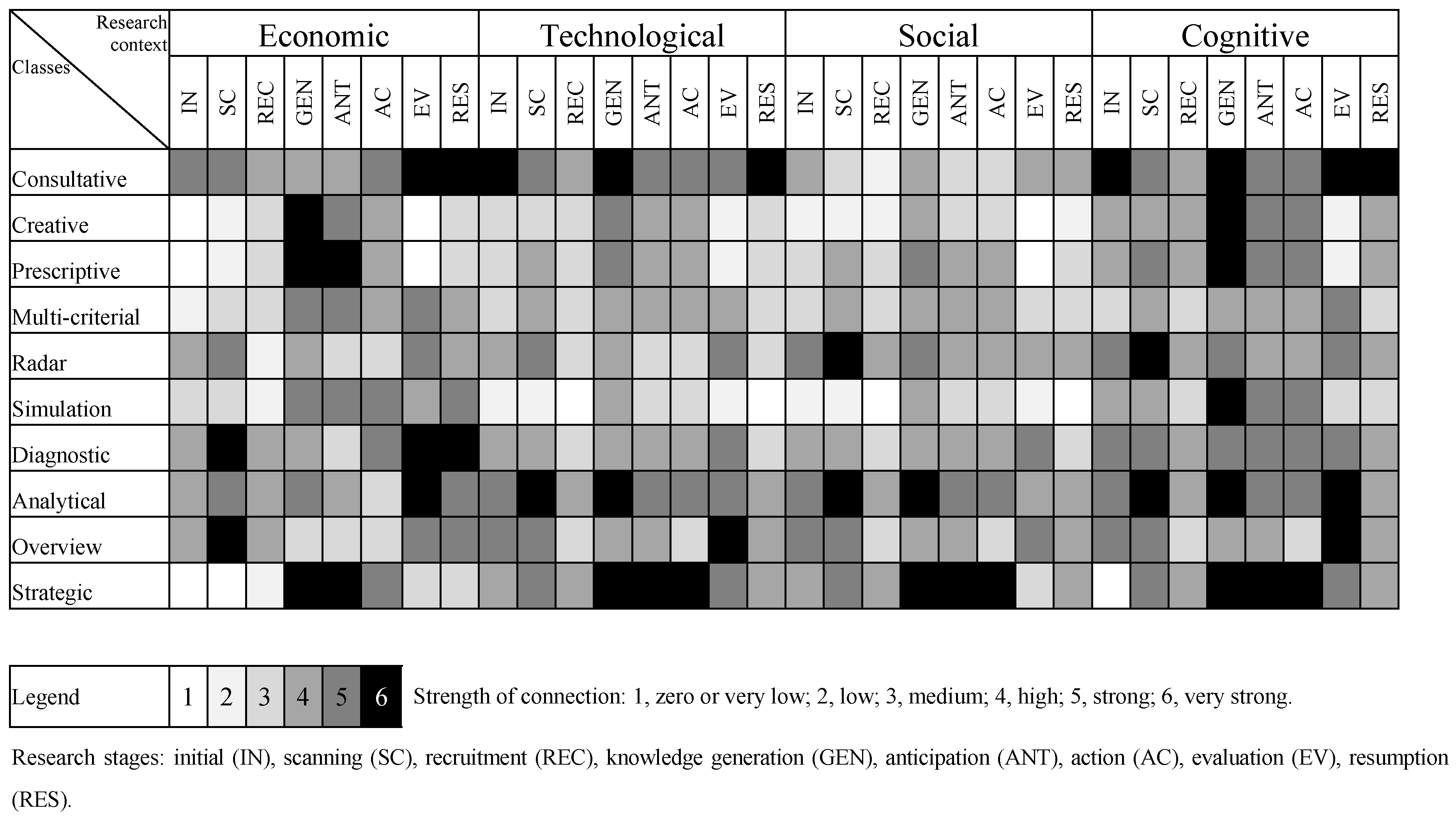
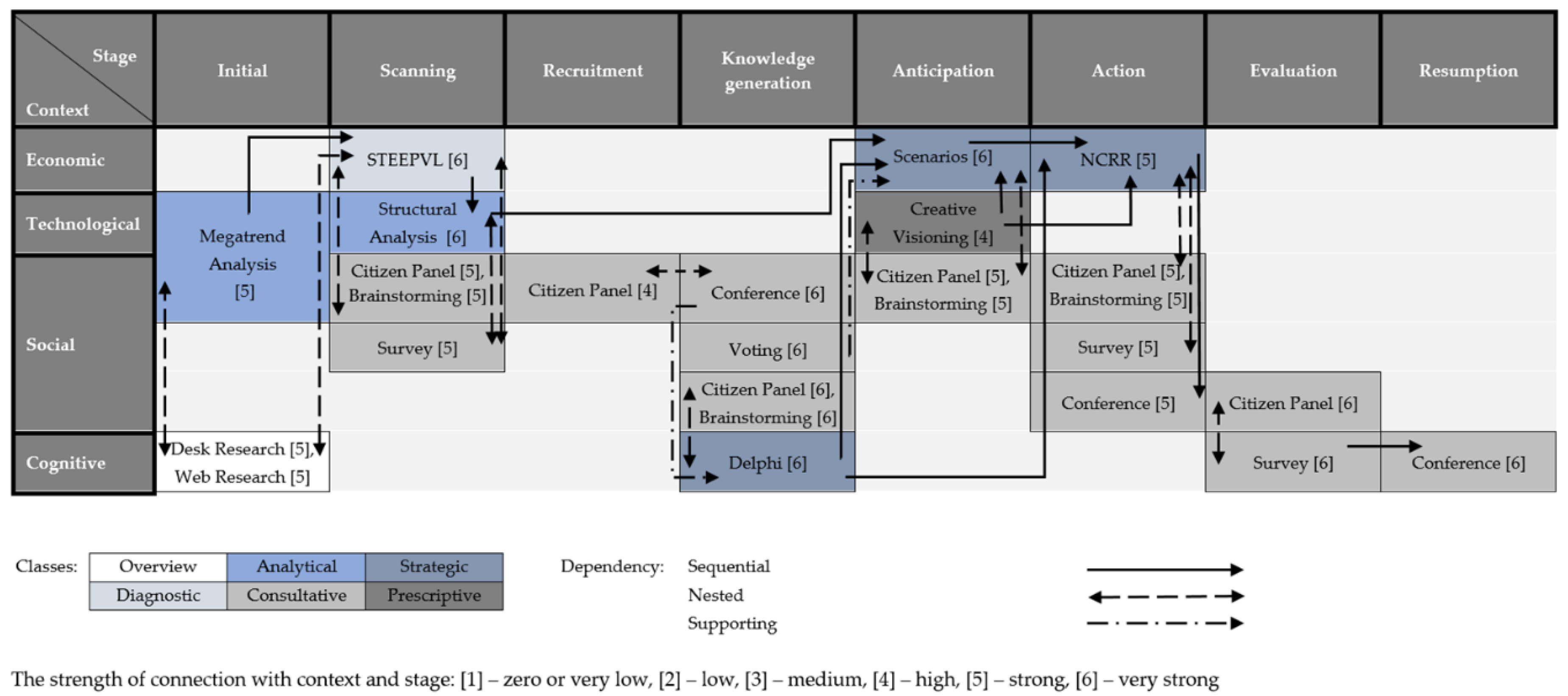
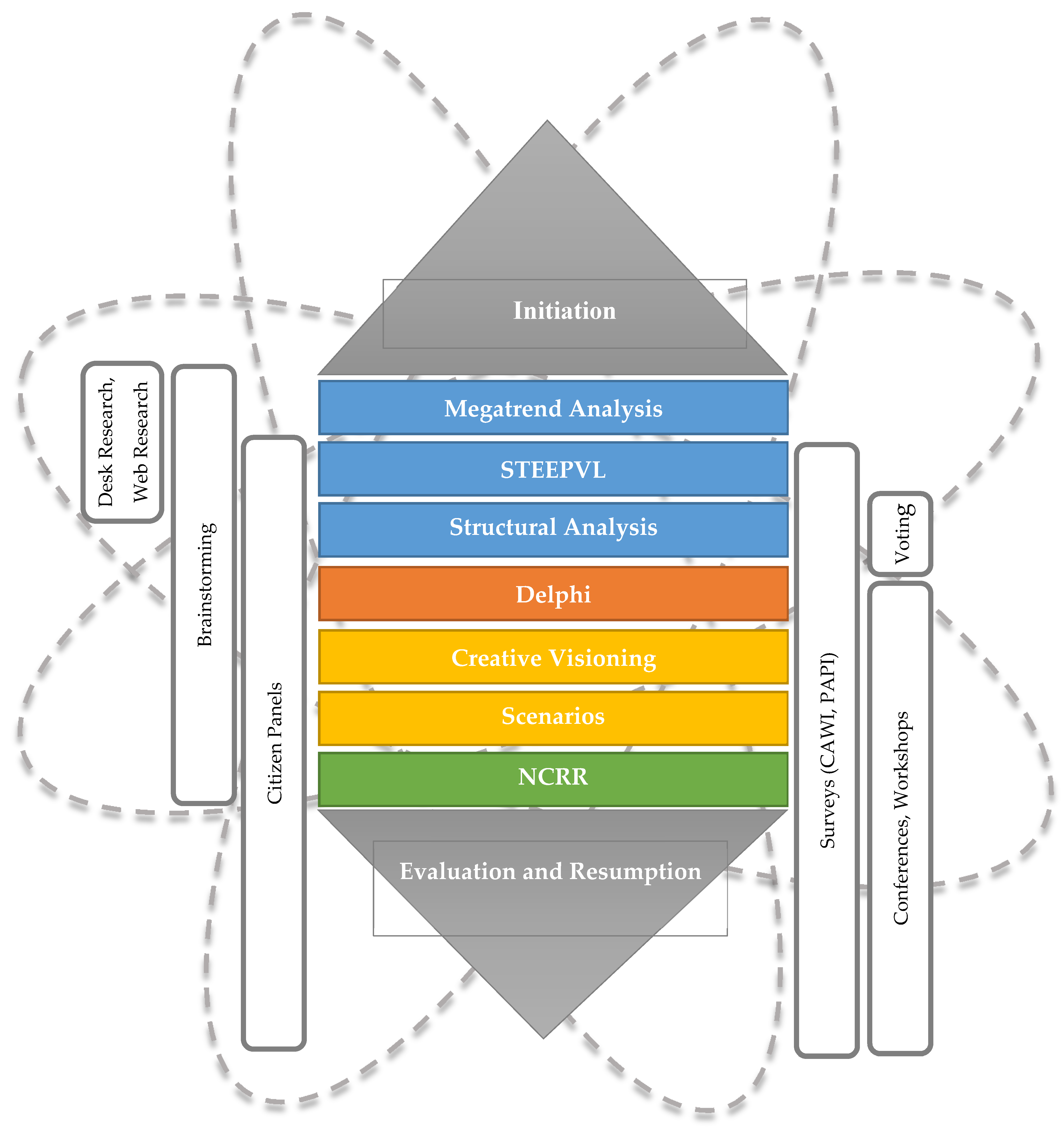
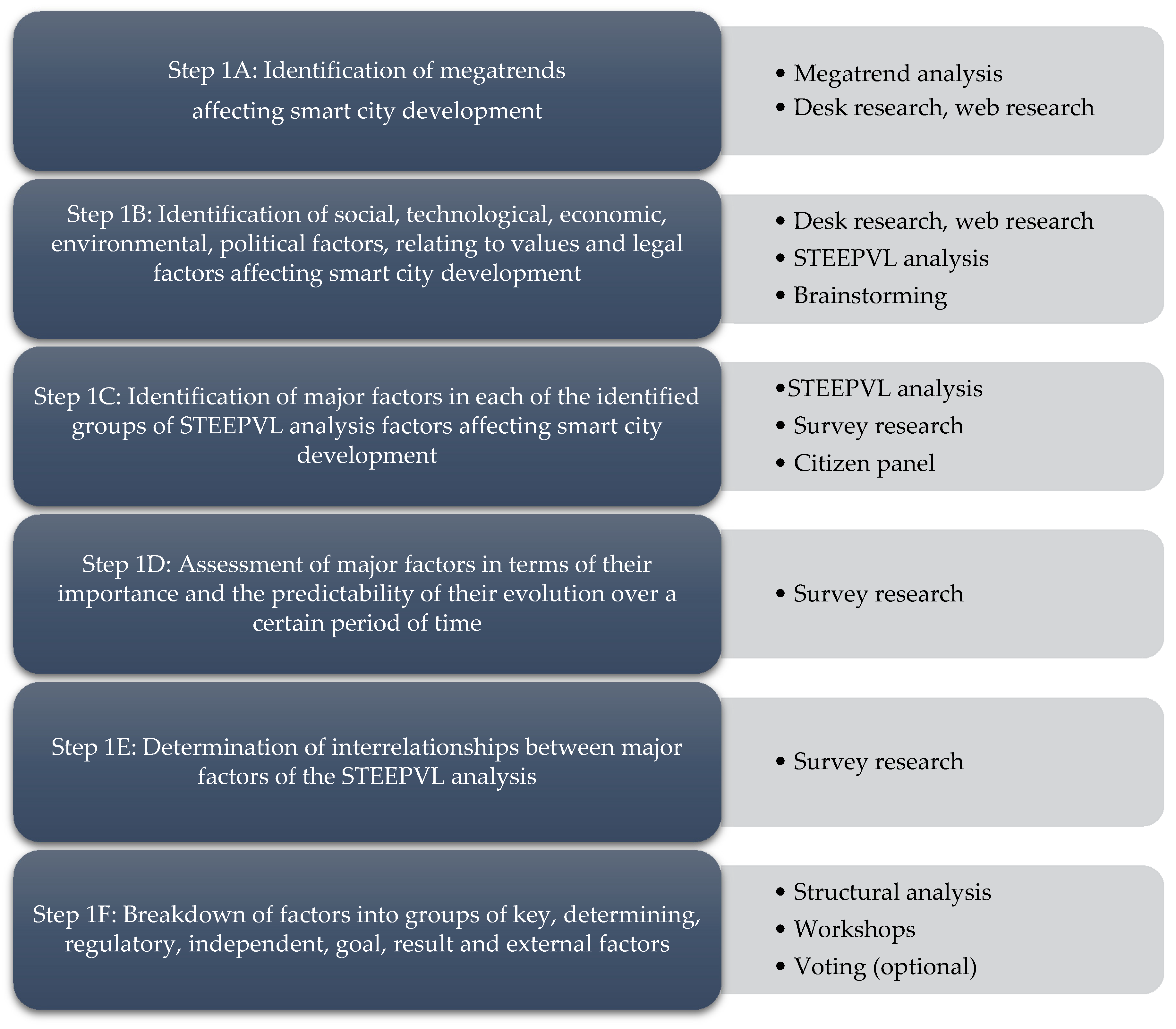
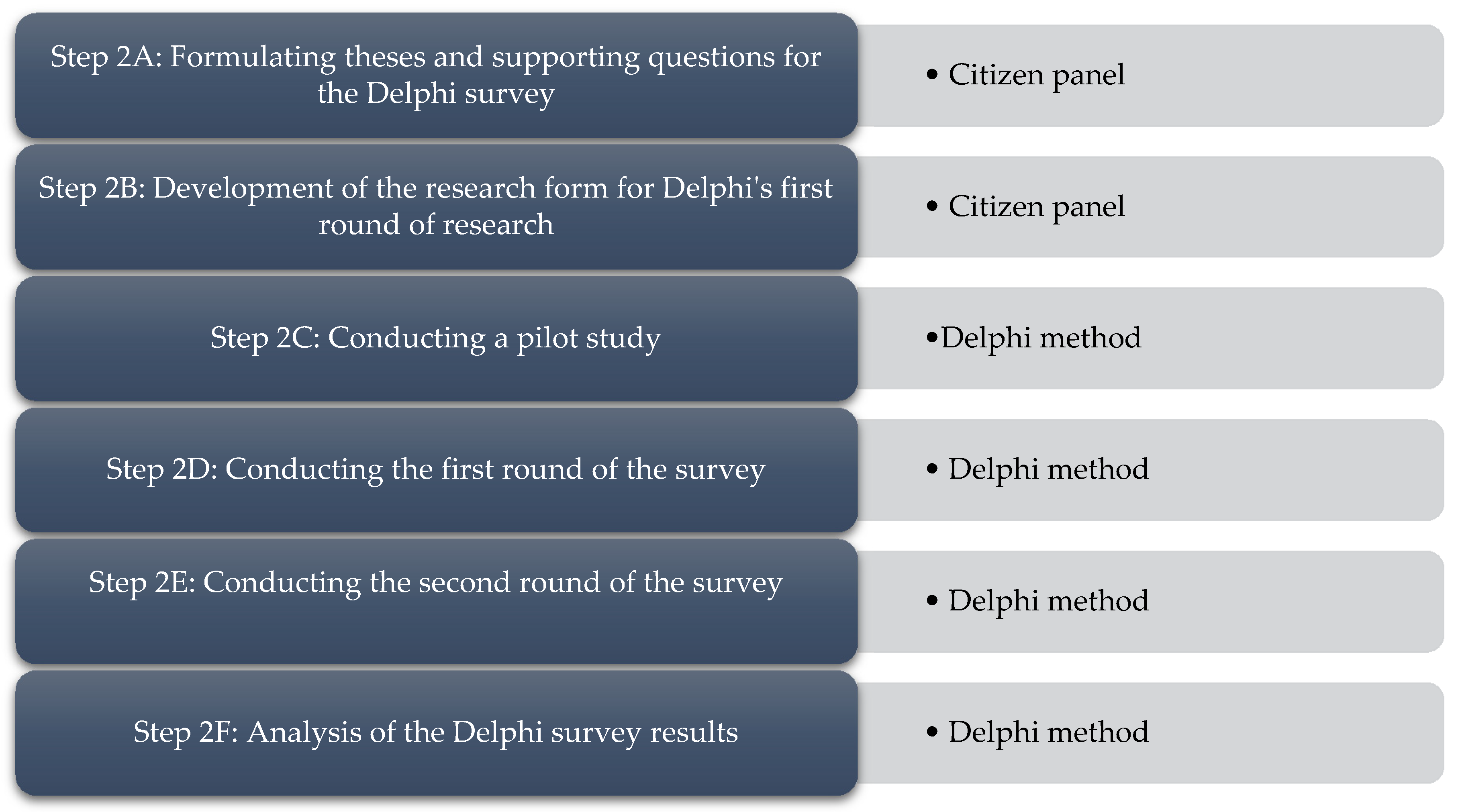
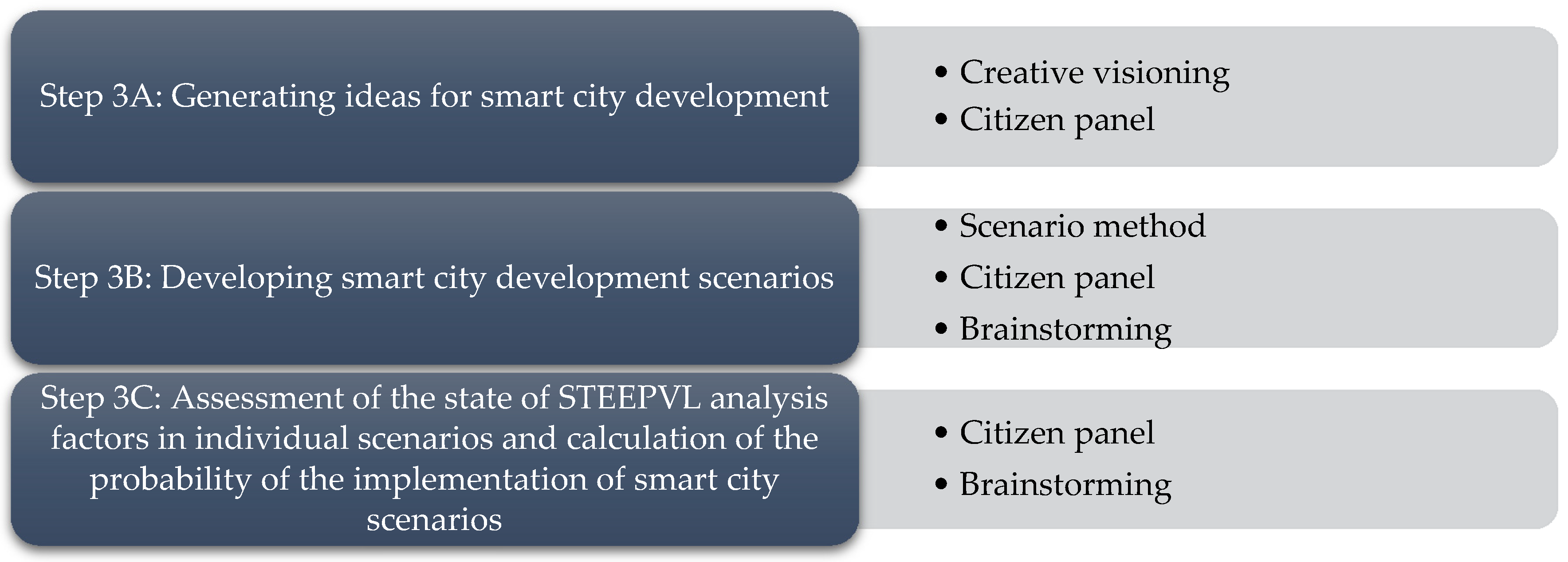
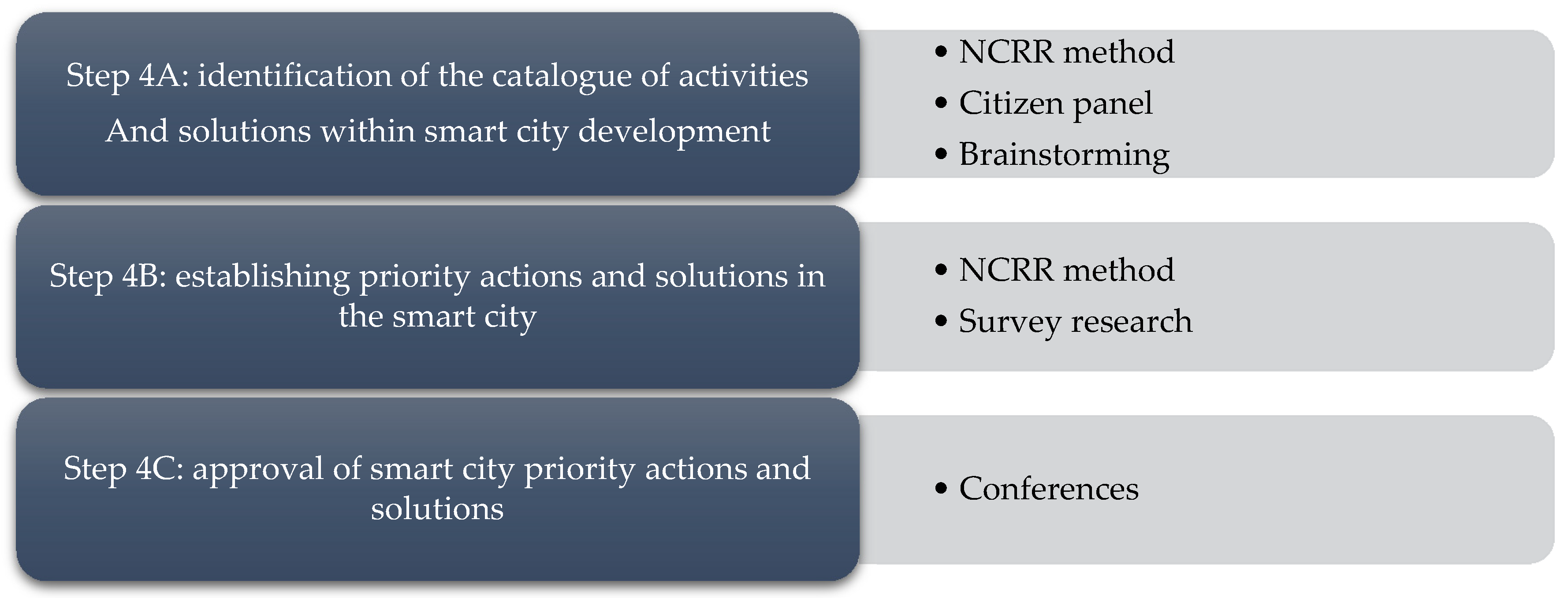

| Classes | Methods |
|---|---|
| Consultative | Voting, Polling, Survey, Interviews, Expert Panels, Essays, Conferences, Workshops, Citizen Panels, Brainstorming |
| Creative | Wild Cards, Weak Signals, Mind Mapping, Lateral Thinking, Futures Wheel, Role Play, Business Wargaming, Synectics, Speculative Writing, Visualization, Metaphors, Assumption Reversal |
| Prescriptive | Relevance Trees, Morphological Analysis, Rich Pictures, Divergence Mapping, Coates and Jarratt, Future Mapping, Backcasting, SRI Matrix, Science Fiction Analysis, In-casting, Genius Forecasting, Futures Biographies, TRIZ, Future History, Alternative History, Creative Visioning |
| Multi-criterial | Key Technologies, Source Data Analysis, Migration Anal., Shift-Share Anal., DEA, Factor Anal., Correspondence Anal., Cluster Anal., Sensitivity Anal., AHP, Input-Output Anal., Prioritization, SMART, PRIME, MCDM |
| Radar | Scientometrics, Webometrics, Patent Analysis, Bibliometrics, Technological Substitution, S-Curve Anal., Technology Mapping, Analogies |
| Simulation | Probability Trees, Trend Extrapolation, Long Wave Anal., Indicators, Stochastic Forecast, Classification Trees, Modelling and Simulation, System Dynamics, Agent Modelling |
| Diagnostic | Object Simulation, Force Field Anal., Word Diamond, SWOT, STEEPVL, Institutional Anal., DEGEST, Trial and Error, Requirement Anal., Theory of Constraint, Issue Management, ANKOT |
| Analytical | SOFI, Stakeholder Anal., Cross-Impact Anal., Trend Impact Anal., Structural Anal., Megatrend Anal., Critical Influence Anal., Tech. Barometer, Cost-Benefit Anal., Technology Scouting, Technology Watch, Sustainability Anal., Environmental Scanning, Content Analysis, FMEA, Risk Anal., Benchmarking |
| Overview | Web Research, Desk Research, Technology Assessment, Social Network Anal., Literature Review, Retrospective Analysis, Macrohistory, Back-View Mirror Analysis |
| Strategic | Technology Roadmapping, Technology Positioning, Delphi, Scenarios, Social Impact Assessment, RPM, Technological Scanning, Multiple Perspectives Assessment, Causal Layered Analysis, MANOA, Action Learning, NCRR |
© 2020 by the author. Licensee MDPI, Basel, Switzerland. This article is an open access article distributed under the terms and conditions of the Creative Commons Attribution (CC BY) license (http://creativecommons.org/licenses/by/4.0/).
Share and Cite
Szpilko, D. Foresight as a Tool for the Planning and Implementation of Visions for Smart City Development. Energies 2020, 13, 1782. https://doi.org/10.3390/en13071782
Szpilko D. Foresight as a Tool for the Planning and Implementation of Visions for Smart City Development. Energies. 2020; 13(7):1782. https://doi.org/10.3390/en13071782
Chicago/Turabian StyleSzpilko, Danuta. 2020. "Foresight as a Tool for the Planning and Implementation of Visions for Smart City Development" Energies 13, no. 7: 1782. https://doi.org/10.3390/en13071782
APA StyleSzpilko, D. (2020). Foresight as a Tool for the Planning and Implementation of Visions for Smart City Development. Energies, 13(7), 1782. https://doi.org/10.3390/en13071782





